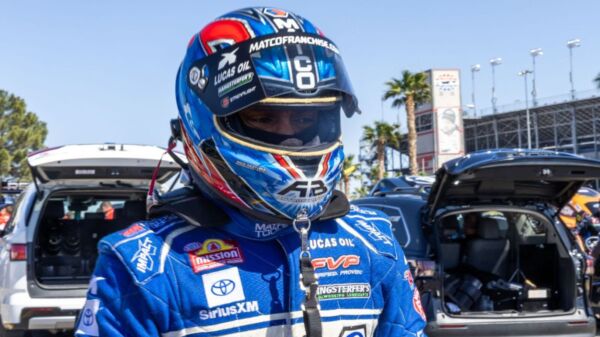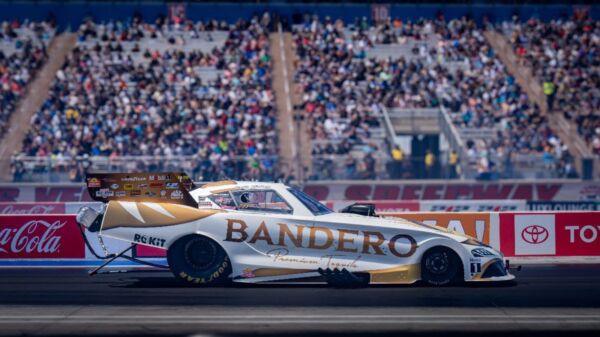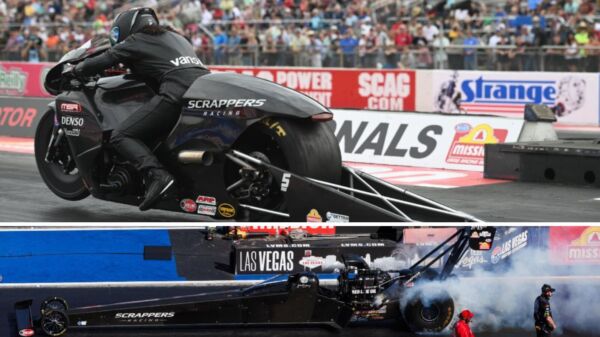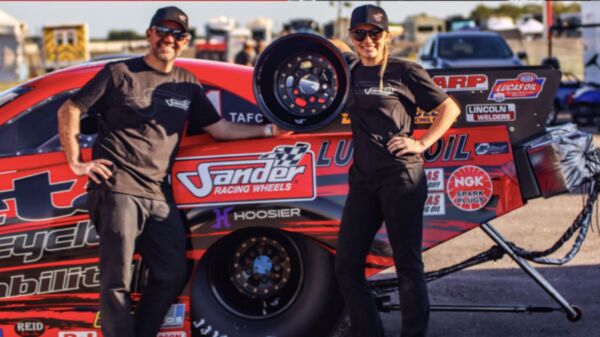The Top Alcohol Dragster category has become a hot destination for many women in the sport of drag racing, either as a forever-home or as a stopping point on the way up. For the last three seasons, a female has been crowned champion in the category, and last year, the NHRA season title came down to the wire with two women locked in an incredibly tight battle.
In early 2022, before this issue of Drag Illustrated was published, five national events featured Top Alcohol Dragster, and between three and five females entered each event – not quite a third of the field, but still significant. Proving that the women should not be taken lightly, Jasmine Salinas won in Gainesville and Julie Nataas was twice the No. 1 qualifier.
[Editor’s Note: This story originally appeared in DI #176, the Women of Power Issue, in May/June of 2022.]
We sat down with five of the female Top Alcohol Dragster racers to get their take on the state of the class and its draw for women. John Finke Racing’s Jackie Fricke, a six-time winner in the category, was neck-and-neck with Rachel Meyer for the championship last season. Two-time national event winner Nataas is leading the charge for Randy Meyer Racing in pursuit of a fourth consecutive championship after sisters Megan (2019 and 2020) and Rachel (2021) claimed titles. Longtime Northeast racer Karen Stalba has begun to turn heads with an effective program and a fast car that has reached four final rounds, while Megan Smith and Taylor Vetter, both relative newcomers, are representing a family legacy in the sport and the challenging supercharged version of the class, respectively.

Julie Nataas (Joe McHugh photo)
Why did you choose Top Alcohol Dragster, and do you see it as a destination or a stepping stone?
FRICKE: That’s easy; for me, it’s a destination. I always say that Finke Racing is my forever team.
When I was six years old, I was at the fence at Maple Grove Raceway and I saw the blown Top Alcohol cars. I decided then and there that one day, I was going to drive one. I literally drew a picture with mine and my sister’s name on a Top Alcohol Dragster, and when we won the [regional] championship in 2014, my sister gave that drawing back to me. She’d saved it all these years. A lot of people dream of Top Fuel, but to me, it was always Top Alcohol Dragster.

Julie Nataas (Rick Belden photo)
STALBA: It was the first class I had the opportunity to try. A family friend had a dragster, and after I graduated college, he asked my father if I wanted to drive. I’d never driven anything else. I was supposed to go run a friend’s door car at Englishtown just to get a little seat time, but it never worked out – so I hopped right into a dragster and made my first pass ever down a dragstrip. I’m happy where I am, and I have a lot of goals I haven’t accomplished in the alcohol car.
NATAAS: I chose Top Alcohol Dragster because I plan to head into Top Fuel dragster one day. I went from Juniors, to Super Comp, to Top Dragster, and then to Top Alcohol. The thing I like most about Top Alcohol Dragster is the competition. I love the class for that, I really do. I know that not everyone wants to go Top Fuel racing, and it’s a lot less expensive to be driving Top Alcohol Dragster.
VETTER: I’ve been active in Top Dragster now for a couple of years, and this was the next step. For me, there was no question that it would be in a blown car, just because of the challenge. I was up for more challenge than what I had in Top Dragster, and I was up for a whole new learning curve as well with the blown car. As for whether or not it’s a stepping stone or a destination, I think it just depends on who you are. I’m doing this as more of a hobby, but if there was an opportunity for a fuel or Pro Stock ride, I’d definitely take it.
SMITH: I chose this class because it’s the nearest thing to Top Fuel, and that’s where I want to be. The procedures are pretty similar, if not the same, and my family and I felt it would be a good stepping stone. It’s a good place to learn and get ready for that next step.
What do you think is most difficult about competing in this class?
FRICKE: The tuning aspect of it, for sure. I was never interested in it before, but now I’m probably interested in it as much or more than driving.
STALBA: Right now, with the price of fuel, it’s hard for people to show up. From the driver’s standpoint, I don’t find it difficult in the way that some people would think. I don’t think that because I’m a woman I was given any less of an opportunity, and I know years ago some of the guys would look at you like, ‘I don’t want to get beat by a girl.’ But I don’t see that, and I never did. People out there are going to give you a hard time whether you’re male or female if you have a competitive car.

Jackie Fricke (Rick Belden photo)
NATAAS: The rule changes that come because you have both blower and nitro-injected cars. For example, this year, we had to change the temperature on our fuel. Other than that, there’s a lot of competition in this class – but I love that.
VETTER: Not for me as a driver, but tuning it. So many things can go wrong that can cost you a round, a race, or a qualifying run. Driving a blown car, you have to hit your shift points, then there’s the whole clutch setup, air gap, and making sure everything is right so that you’re comfortable as a driver.
SMITH: Just the amount of experience needed to do well. But there’s also the tuning side of it, and the more experienced teams seem to have a much better handle on getting the tune-ups. We’re pretty new to this, so that time and experience is something we don’t have yet. Those more experienced teams have been amazing giving us guidance as we’re learning and getting time under our belts.

Karen Stalba (Rick Belden photo)
Do you think there is a specific reason that this class has become populated by so many female drivers?
FRICKE: I just think more women want to race now, and in all honesty, an alcohol dragster is a lot easier to drive than a Funny Car, whether you’re a man or a woman. With the rental programs out there, you can get into a dragster easier. You don’t see a rental program for a blown alcohol Funny Car because you’re not going to be successful doing that. A/Fuel cars are way easier to drive, but they’re not nearly as fun as a blown car. As a parent, I also think it’s more appealing to put your child in a dragster, just from a safety standpoint.
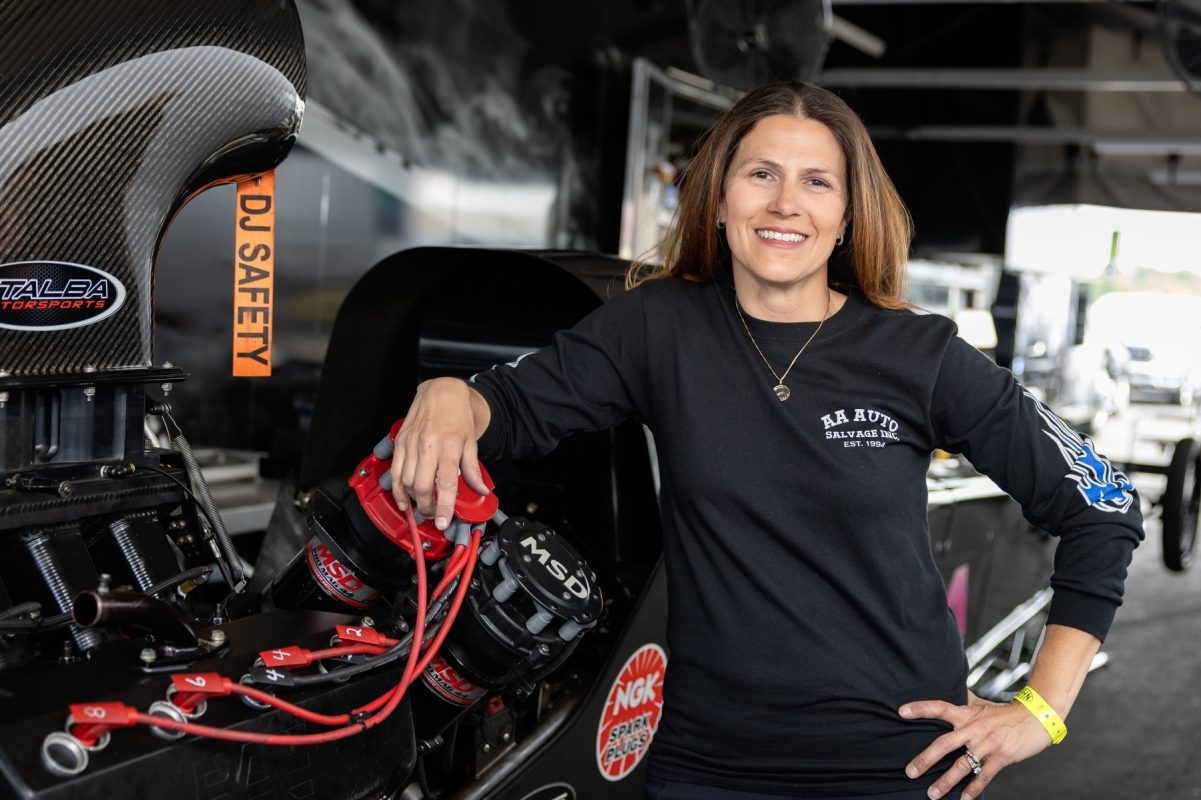
Karen Stalba (Rick Belden photo)
STALBA: I just think more drivers, in general, are leaning toward dragsters. The cost of running blown cars has skyrocketed and been impacted by parts availability – and the way they’re run, they’re a lot harder on parts. I started in a blown car, and I miss the challenge of it, but A/Fuel is easier on the pocket book and a little easier to drive. I don’t miss the cost of the blown car and constantly having to pull the blower off. There’s a lot more work involved.
NATAAS: I don’t think it has anything to do with being easier for a woman than a man. I think the class is attractive to a lot of drivers because it’s a stepping stone to Top Fuel, and you see in alcohol Funny Car there aren’t as many cars actually out there competing together. There are so many dragsters, which is what makes it competitive.
VETTER: For me, I’m just comfortable in a dragster. I raced Super Comp, Top Dragster – it’s always been dragsters for me, and maybe a few years down the road I’ll hop into a Funny Car just to change it up and have that experience, but right now it’s just about my comfort level.
SMITH: I think part of it is that it’s less financially stressful than, say, the Pros in Top Fuel. But the part is that it’s a stepping stone to Top Fuel. I think in the next 10 years or so, you’re going to see eight women in Top Fuel. I think that’s where it’s going. For me, I want to make a step into nitro Funny Car because both sides of my family have been in Funny Car. I would like to venture there, and I think Top Alcohol Dragster and Top Fuel are the building blocks to that.

Jackie Fricke (Joe McHugh photo)
This one is for drivers who have been here for a while. How have you seen the category change over the years?
FRICKE: It’s changed a lot in the rental programs that are available. I’ve always paid for a ride, ever since day one, but a lot of that is in hard work and the sponsors I bring to the table. I could never afford to rent the cars like some. It’s kind of like the Pros; before, you could be a good driver and get a ride, but now, you have to bring sponsorship money.
STALBA: I think we’re getting a lot more recognition than we used to in the alcohol classes. It’s the second-quickest and -fastest motorsports class out there, and people are starting to see it in a different light. You can go fast and represent your sponsors and turn people’s heads now. It’s amazing. Television doesn’t do it justice, but when people walk up to the cars in the pits, they can see all the technology.
What do you think could make Top Alcohol Dragster better?
FRICKE: In a way, the alcohol classes are on an island. A lot of the fans in the stands don’t understand that there is a huge difference between Top Fuel and alcohol. I think that a little more promotion could help us become a lot bigger. I’ve been strapping into the car and heard the announcers telling the fans not to worry, the Pros will be back on track at such-and-such a time. That’s just telling the fans that these cars aren’t exciting, and they are. There is so much work and time and effort and money that goes into this class. Every time I get to strap in this car, I feel like the luckiest human in the world because it’s so exciting.
STALBA: So much of the focus is on the Pros, but to grow the sport, you have to start introducing the slower and smaller classes so that people can get their foot in the door. They’ve come a long way with TV coverage and giving a face to the drivers, and I think that’s a big thing. Personal stories is what so many people want to see.
NATAAS: I think the question is what are we going to do with the rule changes between the blower and nitro-injected cars. There are always people up against each other wanting rule changes, but it doesn’t seem that anyone actually ever agrees.
VETTER: The parity between A/Fuel and blown cars is a struggle, but this is a class I’m choosing to race, so it’s something I have to learn to deal with. Ultimately, I think it will help me become a better driver. I’ll have to figure out how to be more consistent on the tree and have way better lights if I’m the slower car and all the A/Fuel cars are just faster.
SMITH: Right now, it’s about the parity between the blown cars and the injected cars. It would be cool to see more blown cars out there. We need to adjust the injected cars to make the parity right.
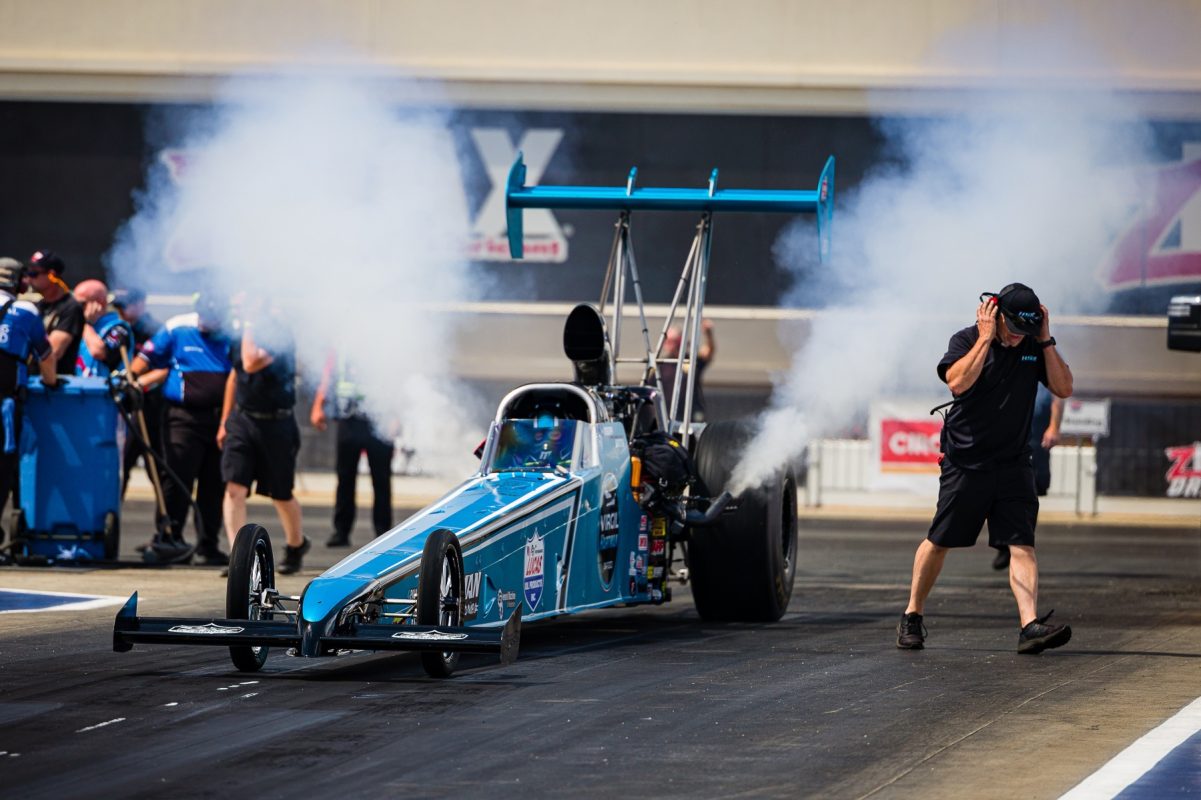
Megan Smith (Rick Belden photo)
What do you see for the future for the class?
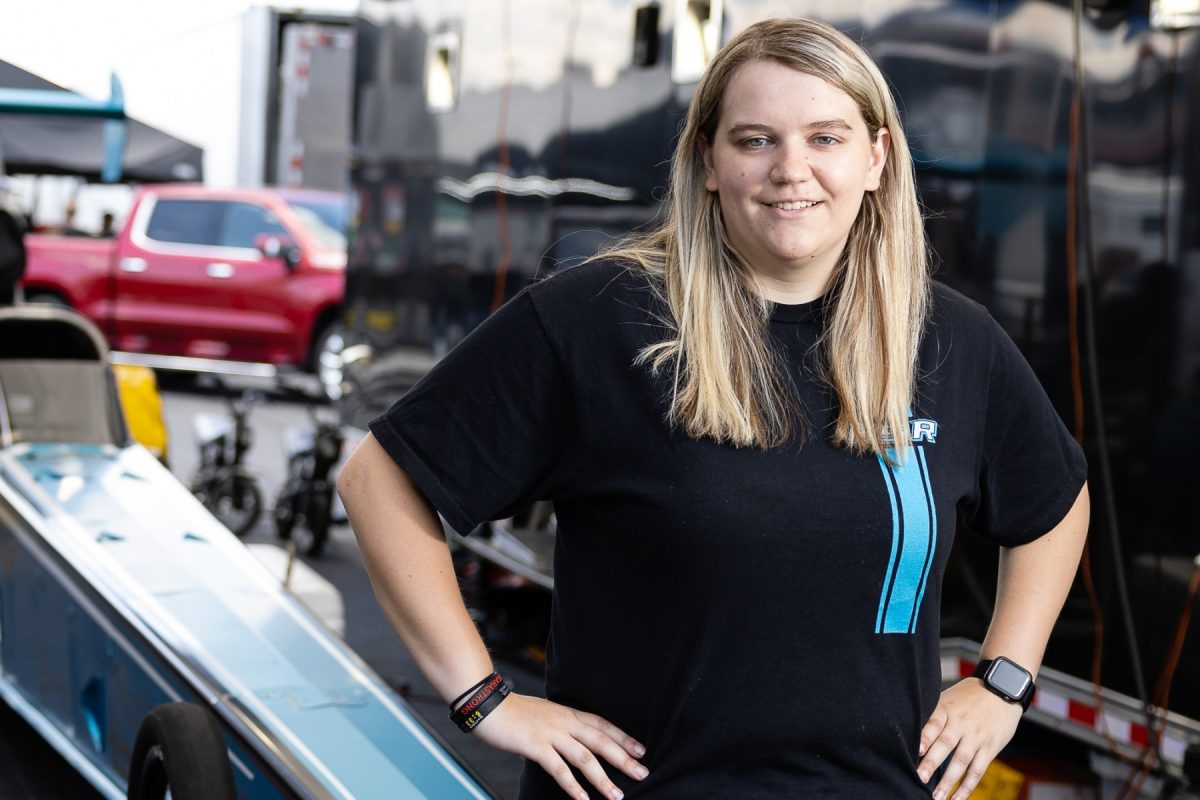
Megan Smith (Rick Belden photo)
FRICKE: I hope it continues to grow, and that the promotion aspect of it increases a little bit to attract more sponsors and more people to the class. This year has been a little bit of a resurgence with some new people getting in, and that’s nice to see. I hope that trend continues.
STALBA: Hopefully, it keeps growing the way it is. A lot of the national events have had full fields, and there are a lot of people renting a ride. That’s good because it allows people to get their foot in the door without having to make a big investment. As the economy turns around, hopefully more drivers will come to the class. There are more of us women out there now, and maybe that encourages more to step up. We need the guys out there, too, though. We need everybody to make this sport work and make it competitive.
NATAAS: I see a lot of newer drivers out there, and I can definitely see them competing with us in the top 10, on an even better level than they are now. I see a lot more competition in the future, and a lot more cars at events.
VETTER: For me, I’m going to hope for more competitive blown cars. I don’t know if that will happen or not, but I hope that there’s consistency throughout the class. I’d like to see consistency so that it’s fair for everybody, no matter what engine combination you decide to run.
SMITH: I think more women will come to the class, and I’m hoping there is more diversity in the drivers. I’d also like to see some different national events or regionals on the schedule that would make it easier for the Southeastern teams.

Taylor Vetter (Rick Belden photo)
Do you have any advice that you would give to someone interested in racing Top Alcohol Dragster?
FRICKE: Never give up. Do whatever it takes, because it’s totally worth it. Never give up on your dreams; where there’s a will there’s a way. My family was not involved and knew nothing about alcohol – they thought I was crazy when I did this. My stubborn attitude helped in that respect.

Taylor Vetter (Rick Belden photo)
STALBA: I would say, go for it. It isn’t easy, but don’t get discouraged. If it’s something you really want, there are opportunities out there. Find a team willing to take a new driver, or head to Frank Hawley’s drag racing school. Yes, it’s an investment – but if this is something you want to do, it will be worth it.
NATAAS: Go get some experience in a class or car that’s slower before getting into the Top Alcohol Dragster so that it won’t be such a huge difference to go 280 mph. You’ll know how the car reacts. It can be a dangerous sport, so it’s important to have that foundation of driving a fast car down the racetrack before you even consider stepping into one of these cars.
VETTER: I’m still learning this part, but try to market yourself the best way you can in order to be as successful as you can be. It takes money to have the right parts and pieces you need to win races. You have to have everything you need to qualify for every race and make consistent runs.
SMITH: You might look at it like, this is the next step to Top Fuel, but it doesn’t have to be that heavy. Dip your toe in. Work for a team for a weekend. See if it’s really what you want to do. Don’t be scared.


